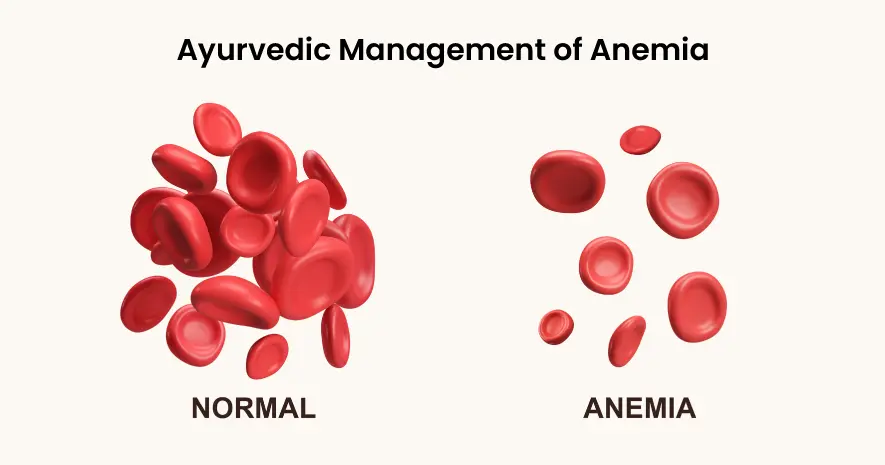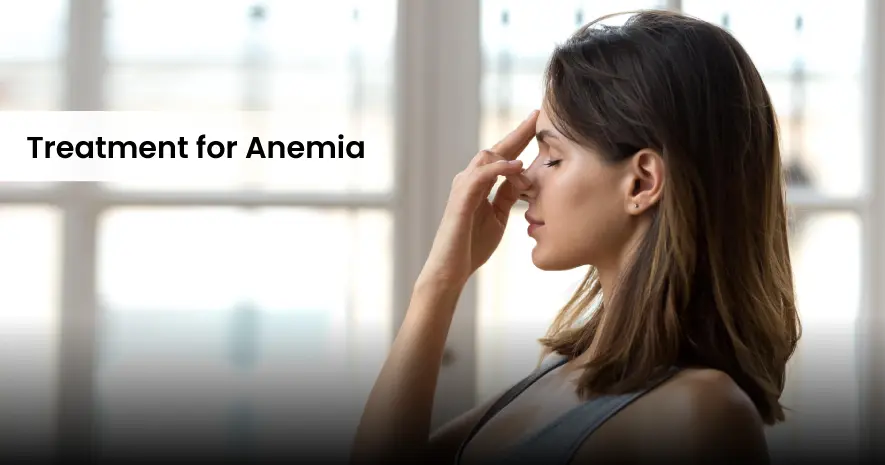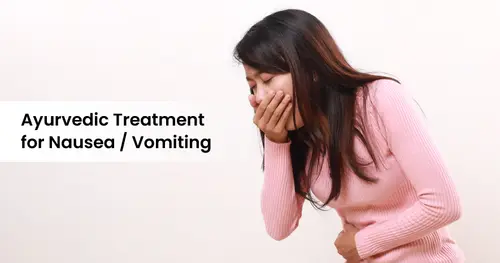
Anemia is a common hematological condition characterized by a deficiency in the number or function of red blood cells, impairing oxygen delivery to tissues. Red blood cells, synthesized in the bone marrow, contain hemoglobin, an oxygen-binding protein crucial for cellular metabolism. When the quantity or efficacy of these cells declines, systemic hypoxia ensues, leading to symptoms such as fatigue, pallor, dizziness, dyspnea, tachycardia, hair loss, brittle nails, and diminished cognitive function.
Modern medicine categorizes anemia based on etiology, including iron deficiency anemia, megaloblastic anemia (due to vitamin B12 or folate deficiency), hemolytic anemia, aplastic anemia, and genetic disorders like sickle cell anemia. Contributing factors range from acute or chronic blood loss (trauma, menstruation, peptic ulcers), inadequate erythropoiesis (nutritional deficiencies, bone marrow dysfunction), and increased red cell destruction (autoimmune or genetic conditions).
Ayurveda approaches anemia from a holistic standpoint, identifying it as Pandu Roga, a condition primarily driven by an imbalance in Pitta dosha, with secondary involvement of Vata and Kapha. The pathology is linked to dysfunctions in Rasa-Vaha Srotas (nutrient transport channels) and Rakta-Vaha Srotas (hematopoietic and circulatory pathways). Weak digestion (Agnimandya) leads to the formation of Ama (metabolic toxins), which obstructs the proper transformation of nutrients into functional blood components. Ayurveda attributes the disease to an improper diet (Apathya Ahara) and detrimental lifestyle habits (Viharaja Nidana), which disturb doshic equilibrium and impair hematopoiesis.
Etiopathogenesis of Pandu Roga:
Pandu Roga arises from multiple causative factors that disrupt the homeostasis of dhatus (tissues), particularly Rasa Dhatu (plasma) and Rakta Dhatu (blood). The consumption of excessively sour (amla), salty (lavana), alkaline (kshara), and spicy (ushna) foods aggravates Pitta dosha, impairing nutrient metabolism and leading to blood deficiencies. Sedentary lifestyles, excessive daytime sleeping, chronic stress, and suppression of natural bodily urges further weaken Agni, reducing the bioavailability of essential hematopoietic nutrients.
The clinical manifestations described in classical Ayurvedic texts mirror modern descriptions of anemia, including loss of appetite, generalized weakness, dizziness, cold extremities, shortness of breath, muscle fatigue, pallor, heart palpitations, and reduced cognitive alertness. In severe cases, individuals may exhibit fever, anorexia, edema, breathlessness, and atrophic changes in the skin and mucous membranes.
Treatment for Anemia
Ayurvedic management of anemia is structured into a multi-phase therapeutic protocol that aims to eliminate causative factors, restore digestive fire, promote blood regeneration, and maintain systemic balance.
1. Nidana Parivarjana (Elimination of Causative Factors)
The cornerstone of Ayurvedic treatment lies in identifying and avoiding dietary and lifestyle triggers that contribute to doshic imbalances. Patients are advised to abstain from highly processed, acidic, and inflammatory foods, while incorporating easily digestible, nourishing, and blood-enriching dietary choices.
2. Deepana-Pachana: Enhancing Digestive Fire and Metabolic Function
Since anemia originates from impaired digestion and nutrient assimilation, Agnivardhaka (digestive stimulants) are prescribed to improve metabolism. Herbal formulations such as Trikatu Churna (combining Pippali, Shunthi, and Maricha) and Hingvashtaka Churna help correct digestive insufficiencies by stimulating gastric secretions and alleviating Ama accumulation.

3. Shodhana: Detoxification and Purification Therapies
To eliminate deep-seated toxins and restore hematopoietic function, Panchakarma therapies are recommended based on patient strength (Rogi Bala).
Snehana (Oleation Therapy): Medicated ghee (ghruta) is administered to soften tissues and pacify aggravated doshas. Triphala Ghruta, Mahatiktaka Ghruta, and Dadimadi Ghruta enhance iron absorption and support hepatobiliary function, crucial for erythropoiesis.
Swedana (Fomentation Therapy): Controlled heat application improves circulation, enhancing the mobilization of metabolic toxins.
Virechana (Therapeutic Purgation): This Pitta-specific detoxification technique expels accumulated toxins via the gastrointestinal tract. Classical formulations like Avipattikar Churna and Triphala Churna help purify the system and optimize nutrient assimilation.
4. Shamana Chikitsa: Ayurvedic Medicines for Blood Replenishment
After purification, Shamana Chikitsa (pacification therapy) is initiated using Lauha-based (iron-containing) formulations, mineral preparations, and hematopoietic herbs.
Punarnavadi Mandura: A potent iron-rich formulation containing Punarnava, Amalaki, Haritaki, Guduchi, and Mandura Bhasma to enhance erythropoiesis.
Trikatrayadi Lauha: A classical Ayurvedic preparation that improves iron metabolism and combats fatigue.
Lohasava and Dhatrarishta: Fermented herbal tonics that improve bioavailability of essential micronutrients.
Draksharishta: Derived from grapes (Draksha), this formulation strengthens blood and supports cardiovascular function.
5. Pathya Ahara: Dietary Modifications for Hematopoietic Support
Ayurvedic nutrition emphasizes iron-rich, easily digestible foods to stimulate blood formation while maintaining digestive integrity. Dietary recommendations include:
Vitamin C-rich fruits like Amla to enhance iron absorption.
Iron-rich vegetables such as Moringa (drumstick leaves), Palandu (onion), and Kharjura (dates) to replenish hemoglobin levels.
Rasona (Garlic) to support circulation and detoxification.
Tila (black sesame seeds) with jaggery, a traditional Ayurvedic iron supplement.
Conversely, fermented foods, excess salt, alcohol, refined sugars, and processed foods should be avoided as they disturb Pitta-Kapha equilibrium and hinder hematopoiesis.
6. Yoga and Pranayama for Anemia Management
Integrating yoga asanas and pranayama improves oxygenation, circulation, and systemic vitality.
Ujjayi Pranayama and Kapalabhati stimulate hematopoiesis by increasing oxygen uptake.
Anulom Vilom (alternate nostril breathing) optimizes cardiovascular and nervous system balance.
Suryanamaskara (Sun Salutations), Sarvangasana (Shoulder Stand), and Trikonasana (Triangle Pose) enhance blood circulation and metabolic activity.
Ayurveda transcends the symptomatic management of anemia, addressing the root causes by restoring digestive efficiency, optimizing nutrient absorption, and harmonizing systemic functions. Unlike modern treatments that primarily focus on iron supplementation, Ayurvedic management integrates dietary interventions, detoxification therapies, herbal medications, and lifestyle modifications to rejuvenate blood health.
By aligning contemporary hematological insights with time-tested Ayurvedic wisdom, this integrative approach offers a sustainable and scientifically sound path for preventing and managing anemia. A personalized regimen—tailored to individual prakriti (constitution), doshic imbalances, and nutritional needs—can restore vitality, resilience, and overall well-being, ensuring a life free from the burden of chronic fatigue and systemic depletion.

December 09, 2025

December 03, 2025

November 26, 2025

November 13, 2025

November 09, 2025

October 27, 2025
We use cookies that are necessary for the smooth operation of the website, to improve our website and to display advertising relevant to you on social media platforms and partner websites. By clicking "Accept all", you agree to the use of cookies for convenience features and statistics and tracking. You can change these settings again at any time. If you do not agree, we will limit ourselves to technically necessary cookies. For more information, please see our privacy policy .